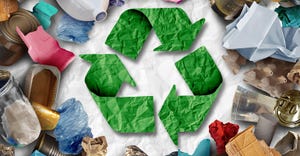County of Hawaii to Reopen Transfer Station Shuttered by Lava Flow
The County of Hawaii is working to put its Pahoa Recycling and Transfer Station back on line after Kilauea volcano forced the facility to close October.
In June, the Kilauea Volcano sent lava flowing across Hawaii's Big Island. The lava flow forced the transfer station to close in October in anticipation of the slow-moving molten rock.
Lava from the volcano actually made its way to the transfer station in November, oozing through a facility fence and pooling on a service road used by trucks hauling refuse containers.
The lava rock has been quite a draw for tourists and locals alike as the facility remained closed as a transfer station but became a popular viewing area for people to see the effects of the lava flow.
This month, the county is paying upwards of $100,000 to return the facility back to a working transfer station, which includes paying a construction company to break up and remove 1,000 cubic yards of lava rock deposited along the driving area, says county Environmental Management Solid Waste Division Chief Greg Goodale.
Construction crews using jackhammers mounted to excavators, broke the rock into pieces small enough to load into dump trucks. Officials estimate crews hauled more than 40 truckloads of rock off site.
Some of the rock is being used on site for some things we're going to build—some walls and things," says Goodale. "A lot of it ended up going to a local quarry."
Cleanup of the lava rock, he added, wasn't easy.
Goodale says he was surprised that the lava had set up as hard as it had. The county was not anticipating how difficult it was going to be to hammer it out of the site.
"It didn't cause much of a delay for the contractor doing the work, but I think we thought it was going to be a little easier to peel that up", he says.
Molten lava, he said, begins hardening right away once it hits surface, making its direction unpredictable.
"Originally when the lava flow was coming into that area, we thought it wasn't going to go toward the transfer station, but because it had hardened in some other areas, it started sending the flow toward the transfer station," says Goodale.
Molten lava starts to harden pretty quickly, he says. It may take the lava, which can reach temperatures of 1,800 to 2,000 degrees F, years to harden as it remains in the tube system, but once it reaches the surface it is quick to solidify.
As long as the supply of molten lava kept coming, says Goodale, it continued to flow down on top of itself, finding the path of least resistance, which in this case was through the facility's fence.
When the facility closed in October, the county's Solid Waste Division was forced to move to an alternate site in Pahoa. Now that the lava rock has been removed, the county will pave the ruined driveway, change signage, finish the repairs and close the alternate site Feb. 28. The impacted Pahoa Recycling and Transfer facility will re-open Mar. 1.
The $3.9 million solar-powered transfer station was dedicated in 2011 as a facility designed to encourage recycling and help residents in the growing Puna communities to efficiently dispose of their trash, County of Hawaii Mayor William P. Kenoi said in a press release.
The facility, which won a SWANA bronze award for facility design in 2012, consists of five separate buildings, and is designed to allow for easy expansion for the growing community. It is the first county transfer station that is solar powered to save on energy costs, and the first that uses a catchment water system.
Still, the lava in the area continues its slow flow. In fact, on Jan. 30, the Mayor made a third supplementary proclamation declaring state of emergency in the area for another 60 days.
While Goodale is confident in the return to operations, he admits it is possible that lava could return to the transfer station.
About the Author
You May Also Like


